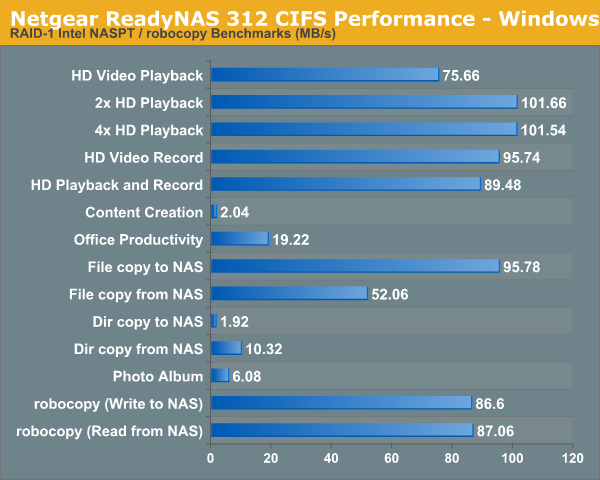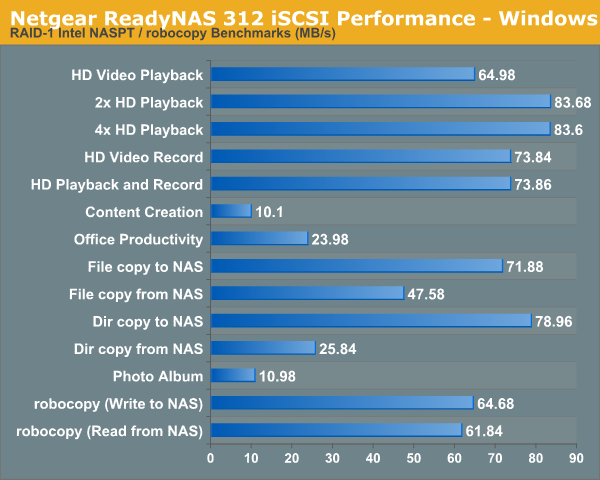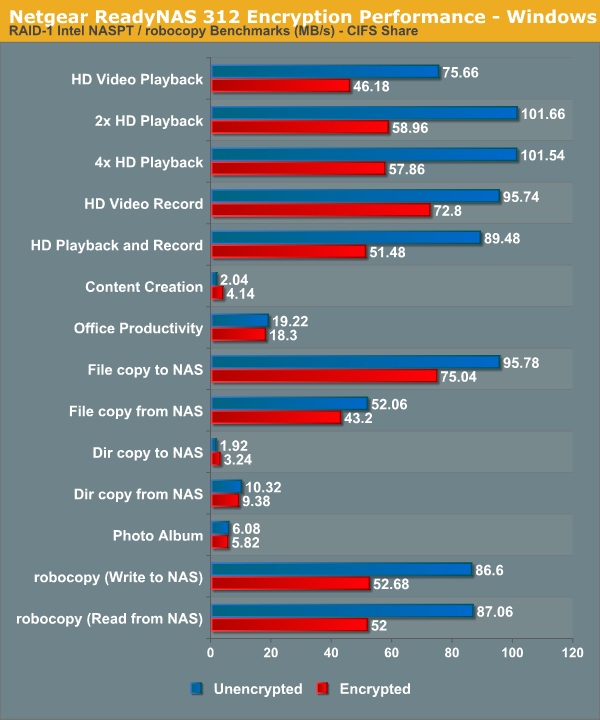Netgear ReadyNAS 312 2-bay SMB / SOHO NAS Review
by Ganesh T S on November 11, 2013 1:00 PM EST- Posted in
- NAS
- IT Computing
- NetGear
- ReadyNAS
Single Client Performance - CIFS and iSCSI on Windows
The single client CIFS performance of the Netgear ReadyNAS 312 was evaluated on the Windows platforms using Intel NASPT and our standard robocopy benchmark. This was run from one of the virtual machines in our NAS testbed. All data for the robocopy benchmark on the client side was put in a RAM disk (created using OSFMount) to ensure that the client's storage system shortcomings wouldn't affect the benchmark results

We created a 250 GB iSCSI target and mapped it on the Windows VM. The same benchmarks were run and the results are presented below.

Encryption Support Evaluation:
Consumers looking for encryption capabilities can opt to encrypt a iSCSI share with TrueCrypt or some in-built encryption mechanism in the client OS. However, if requirements dictate that the data must be shared across multiple users / computers, relying on encryption in the NAS is the best way to move forward. Most NAS vendors use the industry-standard 256-bit AES encryption algorithm. One approach is to encrypt only a particular shared folder while the other approach is to encrypt the full volume. Some NAS vendors have support for both approaches in their firmware, but Netegar only opts for the latter. Details of Netgear's encryption strategy can be found in this forum thread, but the summary is that encryption relies on a key created and stored in a mounted USB drive at the time of volume creation (the volume can't be X-RAID, but has to be set up in a manual RAID level). The USB key needs to be present at boot time for the encrypted volume to be mounted, but, can be removed later. This allows for maximum security, as the encrypted data remains safe even if the unit itself is stolen.
On the hardware side, encryption support can be in the form of specialized hardware blocks in the SoC (common in ARM / PowerPC based NAS units). In x86-based systems, encryption support is dependent on whether the AES-NI instruction is available on the host CPU (not considering units based on the Intel Berryville platform). Unfortunately, the Atom D2701 used in the Netgear ReadyNAS 312 doesn't support AES-NI. However, we are dealing only with a RAID-1 volume. Therefore, impact might not be as brutal as it was seen to be on multi-bay RAID-5-capable NAS units.
We enabled encryption on a volume and created a CIFS share to repeat our Intel NASPT / robocopy benchmarks. The results are presented in the graph below (with the unencrypted volume numbers for comparison purposes).

As expected, encryption carries a bit of a performance hit. In a couple of cases, the numbers seem to even favour the encryption case, but these are within the margin of error for measurements. It goes to show that the bottleneck is on the disk or client side for those cases, rather than the RAID and encryption-related computation on the NAS CPU.










18 Comments
View All Comments
anactoraaron - Monday, November 11, 2013 - link
The only thing that I would add is that Netgear is really taking their ReadyNAS product line seriously with their support. I reviewed on of these units as well (mine came with 2x 1TB Toshiba drives included) and I had some very strange issues with the software (6.0.8). Without going into the details (ejecting external usb drives was one), I notified Netgear about the issue they had a firmware fix the next Monday (firmware was originally 6.0.8 - and was updated to 6.1.1). To me, that was a huge plus. Knowing that your support ticket,etc would be investigated and getting such a fast patch issued shows their commitment to this product line.jaydee - Monday, November 11, 2013 - link
Ganesh,I'm wondering how likely is it, if you were to buy/use this in a home, to actually use the OS that comes with the system, rather than WHS 2011, or a Linux-based server OS (CentOS, etc)? Can you go a bit further with the software aspect of it?
anactoraaron - Monday, November 11, 2013 - link
I would just use the OS that comes with it. There's other features of the OS (like Power Timer) that allow you to set a schedule for when the NAS is on - and it also has WOL functionality. Inside the OS is support for SMB, AFP, NFS, FTP, iTunes, ReadyDLNA, etc. Also in the OS is a free antivirus.There's also a one touch backup button that can be configured to whatever you want to backup (like just certain shared folders) or you can schedule automatic backups. There's nothing too special about the OS, but there's really nothing missing from it either.
ganeshts - Monday, November 11, 2013 - link
I agree with anactoraaron. This is an off-the-shelf NAS. If the software features don't fit, you are better off with a WHS server or custom Linux DIY build. Also, as far as I can see, the only complaint that can be put forward 'core-feature-wise' is the lack of LVM support -- i.e, say, you get the 4-bay variant and want to store some data with single disk resiliency and some with dual disk resiliency -- it is not possible with ReadyNAS OS 6.x.tuxRoller - Monday, November 11, 2013 - link
BTRFS includes "lvm" just as zfs does. In fact, that's one of its criticisms.Since btrfs supports redundancy using the chunks model (default 256MB), rather than at the disk level, you can have multiple redundancy options within a single disk (not a great idea for multiple reasons, but should be doable). Of course, you can span this over multiple disks to get the desired effect.
Something like:
mkfs.btrfs -m raid 1 -d /dev/sda -d raid 1 /dev/sdb /dev/sdc
I should think.
ganeshts - Monday, November 11, 2013 - link
I did mention btrfs's LVM support in the article, but the problem is that Netgear's firmware doesn't implement it.tuxRoller - Monday, November 11, 2013 - link
In the article you said it was supposed to be using the code that was employed in Oracle's deployments?ganeshts - Monday, November 11, 2013 - link
Yes, but not all features are exposed to the end-users. I guess the really adventurous users could try out certain things over SSH, but without official support, it is going to be pretty dangerous.jaydee - Monday, November 11, 2013 - link
The feature I had in mind was proxy server for web caching, content filter, security (something like Squid). I realize this is kinda getting away from a "NAS", but with the specs listed, I don't see why it couldn't.bsd228 - Monday, November 11, 2013 - link
While Oracle may now include it, Redhat is still on the fence about it with the upcoming RHEL7, and still is working out stability before endorsing it for performance reasons. If you want a better filesystem, you can get an HP Microserver and pair it with zfs. I'll let others take this netgear experiment.